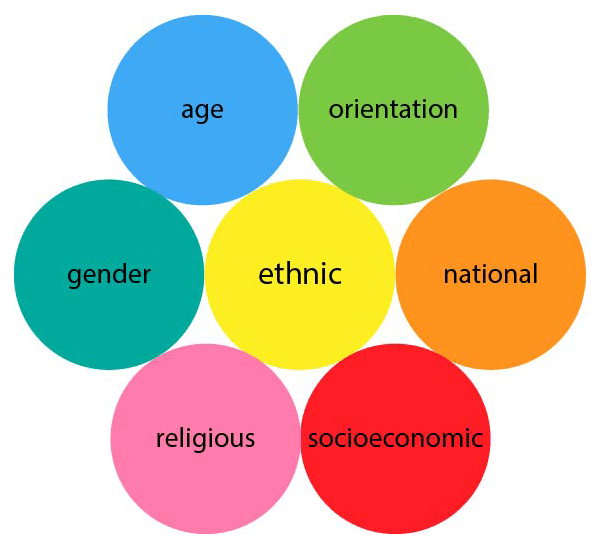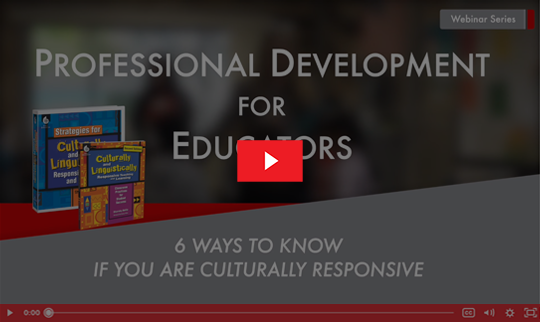What are Rings of Culture in Culturally and Linguistically Responsive Teaching?
This article explains the “Rings of Culture” as an essential component of the culturally and linguistically responsive teaching concept and pedagogy from Culturally and Linguistically Responsive Teaching and Learning: Practices for Student Success, Second Edition. Learn why an understanding of the Rings of Culture is so important to culturally and linguistically responsive teaching and download a free graphic organizer to support responsive educators in considering the many cultures represented in the classroom and in their own responsiveness journeys.
What Are the Rings of Culture?
The Rings of Culture are fundamental to culturally and linguistically responsive teaching. The central feature of culturally and linguistically responsive teaching is students’ ethnocultural identity, but not to the exclusion of the other layered identities that come with culture. The Rings of Culture are age, orientation, nationality, socio-economic status, religion, gender, and ethnicity. These identities, studied in isolation, communicate who we are and why we enact certain behaviors. Each of these rings is a potential source of responsiveness for the educator. Responsive educators account for the multiple, overlapping identities within students. Responsive educators are mindful that race does not determine any behaviors since race is not a culture.

Each of these rings is a potential source of responsiveness for the educator. Responsive educators account for the multiple, overlapping identities within students. Responsive educators are mindful that race does not determine any behaviors since race is not a culture.
What is Culturally and Linguistically Responsive Teaching and Why Is it Important?
 The term Culturally and Linguistically Responsive Teaching and Learning speaks to the comprehensiveness and complexity of the concept. Culturally and linguistically responsive teaching necessitates a deep focus on both culture and language. In Culturally and Linguistically Responsive Teaching and Learning: Classroom Practices for Student Success, Second Edition, culturally and linguistically responsive teaching is defined as “the validation and affirmation of the home (indigenous) culture and home language for the purposes of building and bridging the student to success in the culture of academia and mainstream society” (p. 22).
The term Culturally and Linguistically Responsive Teaching and Learning speaks to the comprehensiveness and complexity of the concept. Culturally and linguistically responsive teaching necessitates a deep focus on both culture and language. In Culturally and Linguistically Responsive Teaching and Learning: Classroom Practices for Student Success, Second Edition, culturally and linguistically responsive teaching is defined as “the validation and affirmation of the home (indigenous) culture and home language for the purposes of building and bridging the student to success in the culture of academia and mainstream society” (p. 22).
In culturally and linguistically responsive teaching, culture is examined from an anthropological framework. In our collective diversity, there are myriad cultural identities. Culturally and linguistically responsive teaching clearly distinguishes between culture and race, and fosters understanding of the importance of avoiding such identity confusion.
The inclusion of the term linguistic in the title of culturally and linguistically responsive teaching demonstrates that the language focus is equal to what we typically consider as culture. Language represents heritage, including family, community, and history.
The focus on culture and language in culturally and linguistically responsive teaching benefits both teachers and learners. As educators work to validate and affirm students through responsive instruction, they develop a pedagogical skill set. Culturally and linguistically responsive teaching offers a pedagogy—the “how” and “why” of teaching, the strategic use of methods, and the rationale behind why instructional decisions are made—instead of content.
The Rings of Culture and Culturally and Linguistically Responsive Teaching
Understanding the Rings of Culture is important to culturally and linguistically responsive teaching. An understanding of the Rings of Culture is directly linked to the process of validating, affirming, building, and bridging, especially as it applies to ethnocultural identity. The Rings of Culture allow educators to look broadly at cultural behaviors to see students as multi-dimensional and avoid pigeonholing.
Conflating culture and race is a common misinterpretation among some individuals who work with diverse groups of students. Rings of Culture represent the various aspects of students’ identities. These identities impact the ways that students interact with each other and the world. All students can benefit from a culturally and linguistically responsive approach, regardless of race.
Distinguishing Among Identities
Simply put, our cultural identity is the way in which we see the world. Culture or ethnic identity differs from race, nationality, and socioeconomic identity in that our ethnocultural identity is passed down from generation to generation.
Mistaking Cultural Identities
Educators must neither mistake one of these cultures for another, nor confuse any of these with race. When these mistakes happen in the classroom, they negatively affect the dynamics of instruction.
Sometimes, who we are ethnoculturally can be mistaken for our national cultural identity and/or our socioeconomic cultural identity. In fact, there are behaviors that we exhibit based simply on our nationality or our economic status.
Consider these two questions:
-
Why do you celebrate the Fourth of July if you are a United States citizen?
-
Where do you wash your clothes?
Before answering the first question, though, ask yourself if you celebrate the Fourth of July because you are White Anglo-Saxon or Mexican (ethnically and not racially speaking) or because you are a citizen of the United States.
For the second question, by knowing where you wash your clothes, I can (most of the time) accurately guess your economic status. If you regularly wash your clothes at a Laundromat, washhouse, or building complex, my guess would be that you are of a lower or working socioeconomic class. If you wash your clothes in your home, then my guess would be middle class. If someone washes your clothes for you, then you might be upper class.
The point is that the Independence Day that you celebrate is determined not by your ethnocultural identity but by your national cultural identity. The way you wash your clothes is not determined by your Black or White ethnicity but by your economic identity.
Avoiding Missed Opportunities
Generalizations and confusion lead to missed opportunities to be culturally and linguistically responsive. Here are two examples.
-
Sometimes, educators will make judgments about African American students’ behaviors as being Black ethnically when the behaviors are more in alignment with lower socioeconomic behaviors. For example, consider the familiar stereotype about some African American or Black students being unlikely to do their homework. Educators who make these assumptions about Black students generalize a socioeconomic behavior (doing homework) as an ethnocultural behavior. Indeed, the fact that some educators would conclude that Black students are less likely to do homework causes these educators to miss the opportunity to be responsive to the economic culture.
-
A persistent cultural myth about Mexican American students is that they value labor over education and often drop out of school because they are not interested in education. In fact, it is often structural economic pressure and depressed wages for Mexican American workers that often burden youth to forgo education to attend to immediate needs. Once again, this would be a consequence of generalizing a socioeconomic behavior as an ethnocultural behavior.
Benefits of the Rings of Culture for Teachers and Students
 The Rings of Culture empower broad discussion and inspire conversation about cultural differences. They help all members of the teaching and learning community avoid generalizations and confusions about culture and race and to acknowledge and account for the multiple, overlapping identities within individuals.
The Rings of Culture empower broad discussion and inspire conversation about cultural differences. They help all members of the teaching and learning community avoid generalizations and confusions about culture and race and to acknowledge and account for the multiple, overlapping identities within individuals.
Considering the Rings of Culture when selecting and evaluating texts for the classroom is a way to ensure that students have access to culturally authentic materials. It can be a challenge to find texts that are representative of who students are, culturally and linguistically. Responsive teachers and administrators think beyond race and ethnic identity to Include books in libraries that address the many Rings of Culture, including gender, socioeconomic status, and youth relevance.
The Rings of Culture are a tool to help educators consider and distinguish among identities with the goal of being culturally and linguistically responsive. Culturally and linguistically responsive teaching is an important part of the work of equity and diversity. Being culturally and linguistically responsive requires both a shift in mindset and developing skills for speaking with, building rapport, relating with, and ultimately teaching students.
Join the journey to responsiveness, a journey of being better educators for students in culturally and linguistically responsive ways. Learn even more about the Rings of Culture and culturally and linguistically responsive teaching in the revised Culturally and Linguistically Responsive Teaching and Learning: Classroom Practices for Student Success, Second Edition.
6 Ways to Know If You Are Culturally Responsive
The world of education is buzzing with talk of being more culturally responsive, but how do you know if you are being culturally responsive? In this on-demand webinar, participants will define cultural responsiveness, learn 6 key questions to gauge your cultural responsiveness and pinpoint progress in the journey to responsiveness.
Author Bio:
View All AuthorsSharroky Hollie, Ph.D.
Dr. Sharroky Hollie is the director of the nonprofit Center for Culturally Responsive Teaching and Learning and the author of Culturally and Linguistically Responsive Teaching, Second Edition (Shell Education, 2018). In addition to this professional book, Dr. Hollie curated a collection of Culturally Authentic and Responsive Texts for Grades K–8 including lessons, a management guide, and digital resources. He is available for keynote presentations.
Join the TCM Blog Community
Subscribe by sharing your email address and we will share new posts, helpful resources and special offers on the issues and topics that matter to you and the children and teens you support.

